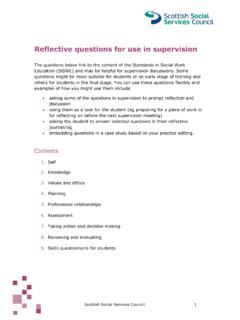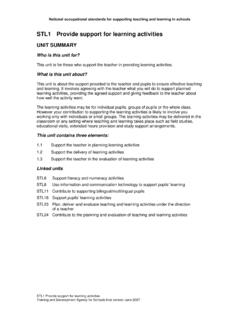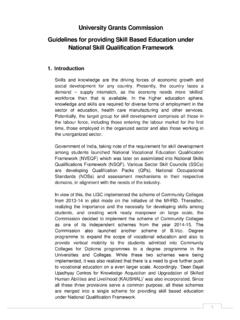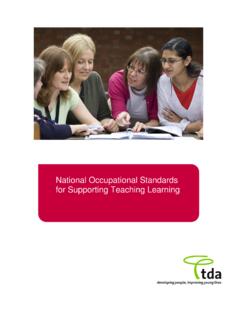Transcription of THE FRAMEWORK FOR CONTINUOUS LEARNING IN SOCIAL …
1 THE FRAMEWORK FOR CONTINUOUS LEARNING IN SOCIAL SE RVICES THE FRAMEWORK FOR CONTINUOUS LEARNING IN SOCIAL SERVICES Produ ce d for the Scottrsh G ove rnm e nt by RR Donn e lley 858362 Revised edition 2014 CONTINUOUS LEARNING FRAMEWORK CONTENTS Page Ministerial foreword 2 Acknowledgements 3 Introduction 5 The purpose of the CONTINUOUS LEARNING FRAMEWORK 6 The key elements of the CONTINUOUS LEARNING FRAMEWORK 7 Using the CONTINUOUS LEARNING FRAMEWORK 11 Appendix 1: Personal capabilities 19 Managing relationships: 21 Empowering people 21 Working in partnership 22 Leadership 23 Empathy 24 Dealing with conflict 25 Managing self: 26 Professional autonomy 26 Lifelong LEARNING 27 Flexibility 28 Confidence 29 Resilience 30 Accurate self-assessment 31 Awareness of impact on others 32 Awareness of wider context 33 Appendix 2: Organisational capabilities 34 Creating a LEARNING and performance culture 36 Planning for LEARNING , development and improved practice 38 Promoting access to LEARNING and development opportunities 40 Promoting access to feedback 42 Treating people with dignity and respect 44 Focusing on health and wellbeing 46 Appendix 3: Practice illustrations 48 Appendix 4: Bibliography 56 Appendix 5: Glossary 58 Appendix 6: Members of the Project Board 60 Appendix 7: Members of the reference pool 61 Appendix 8.
2 Organisations participating in the trials 62 1 CONTINUOUS LEARNING FRAMEWORK Adam Ingram MINISTERIAL FOREWORD The Scottish Government s purpose is to create a more successful country, with opportunities for all of Scotland to flourish through increasing sustainable economic growth. The Concordat between the national and local governments heralds an exciting and challenging time for Scotland s policy development and implementation with a new focus on outcomes. Transforming the outcomes of Scotland s children, families and users of SOCIAL services is a key aim of this Government. To achieve this the Government is developing an Early Years /Early Intervention FRAMEWORK and remains committed to supporting the implementation of the vision set out in Changing Lives: Report of the 21st Century SOCIAL Work Review.
3 The CONTINUOUS LEARNING FRAMEWORK is the key output from the workforce development change programme under Changing Lives . It will make a major contribution to ensuring that our vision of a confident, competent and valued workforce committed to CONTINUOUS LEARNING and development and contributing fully to our ambitions for Scotland, becomes a reality at all levels in SOCIAL services. The FRAMEWORK sets out what all people in the SOCIAL service workforce need in order to be able to do their job well now and in the future. It will improve approaches to three key areas LEARNING and development, career pathways and improved standards of practice. In order to facilitate the use of the FRAMEWORK in practice tools and resources will be developed for SOCIAL service workers and their employers.
4 2 The Scottish SOCIAL Services Council (SSSC) and the Institute for Research and Innovation in SOCIAL Services (IRISS) have developed the CONTINUOUS LEARNING FRAMEWORK in partnership with the sector. The response so far has been overwhelmingly positive. We now need to see employers and workers building on this enthusiasm at a local level to take full advantage of the opportunities presented by the FRAMEWORK . The Scottish Government is committed to supporting this activity. We are providing significant additional financial resources to the SSSC and IRISS to take forward a strategy to promote local ownership of the FRAMEWORK . This will include supporting both employers and their workers to adopt the FRAMEWORK . Employers may need support to decide how best to use the FRAMEWORK in their organisation; while both workers and employers may need support in using the FRAMEWORK in practice.
5 The Scottish Government s vision for transformational change requires purposeful engagement by SOCIAL service workers, managers and employers across the SOCIAL service sector. Given the enthusiastic and constructive approach already demonstrated by the sector during the development of the FRAMEWORK and the Government s ongoing commitment to support this, I am confident that we will succeed. Adam Ingram Minister for Children and Early Years CONTINUOUS LEARNING FRAMEWORK ACKNOWLEDGEMENTS The Scottish SOCIAL Services Council (SSSC) and the Institute for Research and Innovation in SOCIAL Services (IRISS) wish to thank all those who have helped to develop the CONTINUOUS LEARNING FRAMEWORK . We are particularly grateful to the members of our reference pool and the participants in the nine trials.
6 Their insightful contributions have ensured that the FRAMEWORK is both rigorous and grounded in practice. We would especially like to thank all of the people who use services, carers and practitioners groups who contributed so enthusiastically to the development of the FRAMEWORK . Finally, we are grateful to everyone who responded so constructively to the consultation events and the on-line questionnaire and to George Street Research for their analysis of the consultation responses. 3 4 CONTINUOUS LEARNING FRAMEWORK INTRODUCTION The CONTINUOUS LEARNING FRAMEWORK sets out what people in the SOCIAL service workforce need to be able to do their job well now and in the future and describes what employers need to do to support them.
7 It has been developed by the Scottish SOCIAL Services Council (SSSC), the Institute for Research and Innovation in SOCIAL Services (IRISS) and a reference pool of people with a broad range of expertise and experience across the SOCIAL service sector. The CONTINUOUS LEARNING FRAMEWORK aims to enrich rather than replace the systems and processes that many organisations have already developed. This document is for individuals working in the SOCIAL service sector and for the organisations which employ them. It has three main sections. The first outlines the purpose of the CONTINUOUS LEARNING FRAMEWORK , the second describes the four key elements of the FRAMEWORK and the third focuses on using the FRAMEWORK in practice. This third section includes a number of examples of how the FRAMEWORK has already been used by organisations delivering SOCIAL services.
8 Appendix 1 sets out the personal capabilities in full, appendix 2 sets out the organisational capabilities in full and appendix 3 contains three fictional illustrations of how all of the elements of the FRAMEWORK could be used in practice. 5 CONTINUOUS LEARNING FRAMEWORK THE PURPOSE OF THE CONTINUOUS LEARNING FRAMEWORK The CONTINUOUS LEARNING FRAMEWORK aims to continuously improve the quality of outcomes for people who use SOCIAL services by supporting the people who are delivering these services to be the best they can be. This requires a shared commitment from both the worker and their employer. It is important that each individual SOCIAL service worker takes responsibility for their own LEARNING and development throughout their career and that employers provide opportunities for CONTINUOUS LEARNING and improvements in practice.
9 These responsibilities are already set out in the Codes of Practice for SOCIAL Service Workers and Employers of SOCIAL Service Workers which can be found on the SSSC s website at THE CONTINUOUS LEARNING FRAMEWORK AIMS TO SUPPORT SOCIAL SERVICE WORKERS TO: identify their LEARNING needs throughout their career get the most from induction, supervision, performance management and employee development processes improve their practice gain recognition for the progress and achievements they have made over time gain recognition of prior informal LEARNING provide evidence of the impact on their practice of formal and informal LEARNING , including post registration training and LEARNING (PRTL). IT AIMS TO SUPPORT EMPLOYERS OF SOCIAL SERVICE WORKERS TO: identify, analyse and meet the LEARNING needs of their workforce increase the capability of their workforce provide transparent, consistent and detailed person specifications for job roles in their organisation create an organisational culture and conditions which support the recruitment and retention of staff add value to existing systems for induction, supervision, performance management and employee development provide evidence of the impact of LEARNING and development on the quality of service provision and CONTINUOUS improvement.
10 THE CONTINUOUS LEARNING FRAMEWORK IS FOR EVERYONE WORKING IN SOCIAL SERVICES IN SCOTLAND. IT IS FOR PEOPLE: working in all areas of SOCIAL service provision in the public, voluntary and private sectors involved in the delivery and management of frontline services in senior and middle management working in the education, training and development of the SOCIAL service workforce. 6 CONTINUOUS LEARNING FRAMEWORK THE KEY ELEMENTS OF THE CONTINUOUS LEARNING FRAMEWORK When you apply for a job in SOCIAL services, you will usually receive some information that describes the kind of person the employer is looking for. It might describe the qualifications and training and the personal qualities necessary to do the job well. The first three areas in the CONTINUOUS LEARNING FRAMEWORK are very similar.









